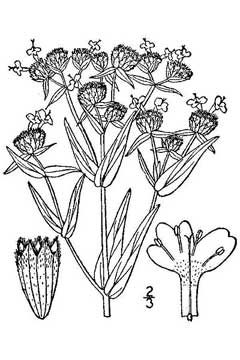
Virginia Mountain Mint
Latin Name: Pycnanthemum virginianum
USDA Hardiness: 4-8
Native Range: NORTHERN AMERICA: Canada, Québec (southwest), Ontario (south), United States, Connecticut, Indiana, Maine, Massachusetts, Michigan, New Hampshire, New Jersey, New York, Ohio, Pennsylvania, Rhode Island, Vermont, Illinois, Iowa, Kansas (east), Missouri, Nebraska (east & central), Oklahoma (central), South Dakota (east), Wisconsin, Arkansas, Delaware, Georgia (north), Kentucky, Maryland, North Carolina, Tennessee, Virginia,
Edibility Rating: 2 / 5
Medicinal Rating: 2 / 5
Region:
Family:
Plant Type:
Medicinal Uses
Edible Uses
Edible Parts: | Edible Uses: Condiment TeaFlower buds and leaves - raw or cooked. A mint-like flavour, they make a nice addition to salads or can be used as a condiment[61, 161, 183, 238]. The fresh or dried leaves are brewed into a refreshing mint-like tea[183].
Cultivation
Succeeds in most soils[1] but prefers a rich loamy soil in full sun or partial shade with plenty of moisture in the growing season[200]. Plants are hardy to at least -15°c[238]. The plant is heat tolerant in zones 8 through 1. (Plant Hardiness Zones show how well plants withstand cold winter temperatures. Plant Heat Zones show when plants would start suffering from the heat. The Plant Heat Zone map is based on the number of "heat days" experienced in a given area where the temperature climbs to over 86 degrees F (30°C). At this temperature, many plants begin to suffer physiological damage. Heat Zones range from 1 (no heat days) to 12 (210 or more heat days). For example Heat Zone. 11-1 indicates that the plant is heat tolerant in zones 11 through 1.) For polyculture design as well as the above-ground architecture (form - tree, shrub etc. and size shown above) information on the habit and root pattern is also useful and given here if available. The plant growth habit is a clumper with limited spread [1-2]. The root pattern is rhizomatous with underground stems sending roots and shoots along their length [1-2].
Known Hazards
None known
Habitats
Gravelly shores, meadows, dry to wet thickets etc[43].